Have you thought about growing your own pear trees? These trees can make your garden a beautiful place. But, how hard is it to grow these tasty fruits? We’ll show you how to grow and care for pear trees in this guide.
Pear trees have lovely spring flowers and beautiful fall leaves. They also let you pick your own fruit. You can pick a pear tree that fits your garden size, from small to big. Growing your own pear trees is fun and opens up new cooking possibilities.
Are you ready to start a tasty journey and learn about pear trees? Let’s dive into our guide and see what these amazing trees can do.
Selecting the Right Pear Tree Variety
Choosing the right pear tree is key to success. Pear trees come in many types, each with special traits like cold hardiness, fireblight resistance, and when they ripen. Picking varieties that fit your local climate is crucial for a good harvest.
Cold-Hardy Pear Varieties
For gardeners in the north, here are some pear varieties that can handle the cold:
- Golden Spice
- Gourmet
- Juicy Jewel
- Luscious
- Parker
- Patten
- Ure
Pollination Requirements for Pear Trees
Most pear trees need another pear tree to pollinate them for a good fruit set. But, some pear types can pollinate themselves. Picking the right pear varieties is important for fruit production in your garden.
| Pear Variety | Pollination Requirements |
|---|---|
| Bartlett | Requires cross-pollination |
| Seckel | Self-pollinating |
| D’Anjou | Requires cross-pollination |
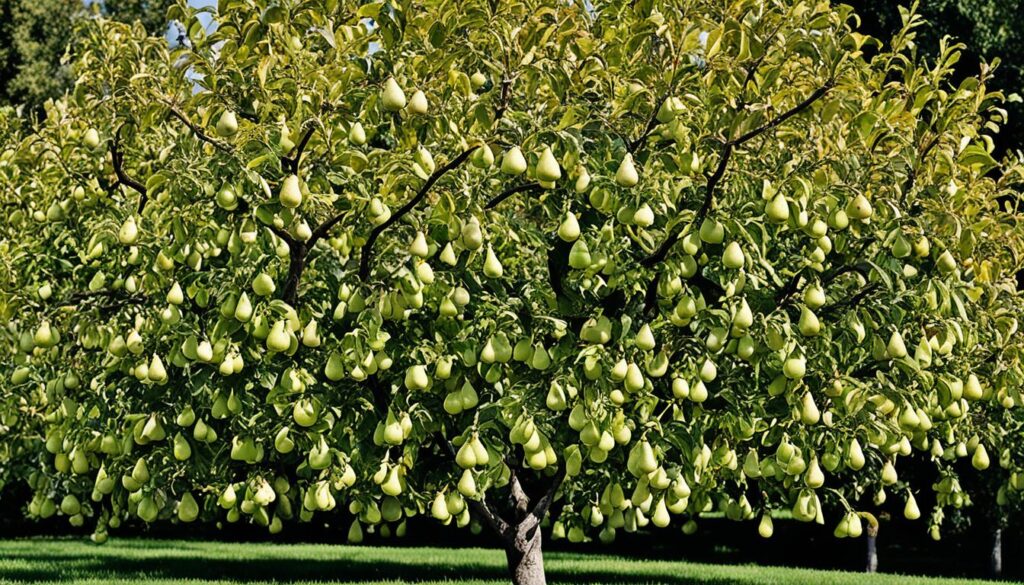
Preparing the Planting Site
Choosing the right spot for pear trees is key to their growth. They do best in soil that drains well and is a bit acidic. The ideal pH is between 6.0 and 7.0. Before you plant, test the soil and add compost or organic matter if needed.
Soil Considerations for Pear Trees
Make sure the spot gets full sun and is away from other trees or buildings. Stay away from places that often freeze, as this can hurt the trees. By picking and preparing the right spot, you help your pear trees grow well.
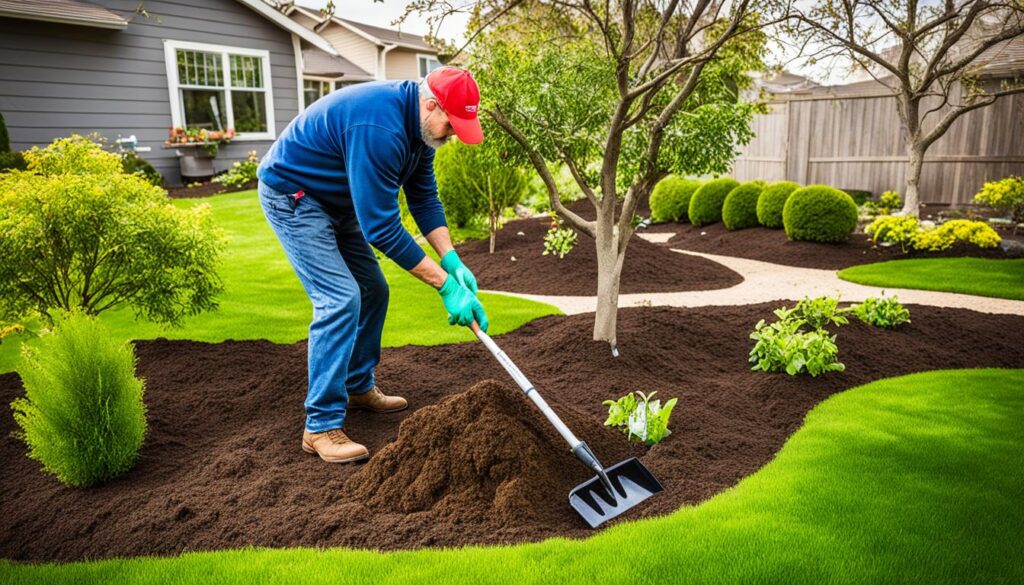
- Pear trees prefer well-drained, slightly acidic soil with a pH between 6.0 and 7.0.
- The planting site should be in full sun, away from structures or other trees.
- Avoid areas prone to frost, as this can damage the trees.
- Have the soil tested and amend it with compost or organic matter as needed before planting.
Think about the soil and choose the best spot for your pear trees. This way, you’ll get a great harvest in the future.
Planting pear trees
Pear trees can do well in your garden, whether you pick bare-root or potted ones. The key to success is getting the site ready and placing the tree right. Start by digging a hole that’s three times the width of the root ball and just as deep. This gives the roots enough room to spread and grow.
For bare-root pear trees, plant them in early spring. For potted trees, you can plant them any time of the year. Fill the hole with a mix of native soil and organic stuff like compost or manure. This mix will feed the tree as it gets settled.
Put the pear tree so the graft union is 2-4 inches above the soil. This stops the union from getting buried, which can cause problems. Also, put a tree guard around the trunk to keep it safe from winter damage and other harm.
| Planting Type | Timing | Depth | Soil Mix | Graft Union | Tree Guard |
|---|---|---|---|---|---|
| Bare-root | Early spring | 3x width of root ball, same depth | Native soil + organic matter | 2-4 inches above soil line | Recommended |
| Potted | Year-round | 3x width of root ball, same depth | Native soil + organic matter | 2-4 inches above soil line | Recommended |
Follow these steps to grow a healthy pear tree in your garden, with bare-root trees or potted trees. With the right care and planting, your trees will soon give you lots of fruit.
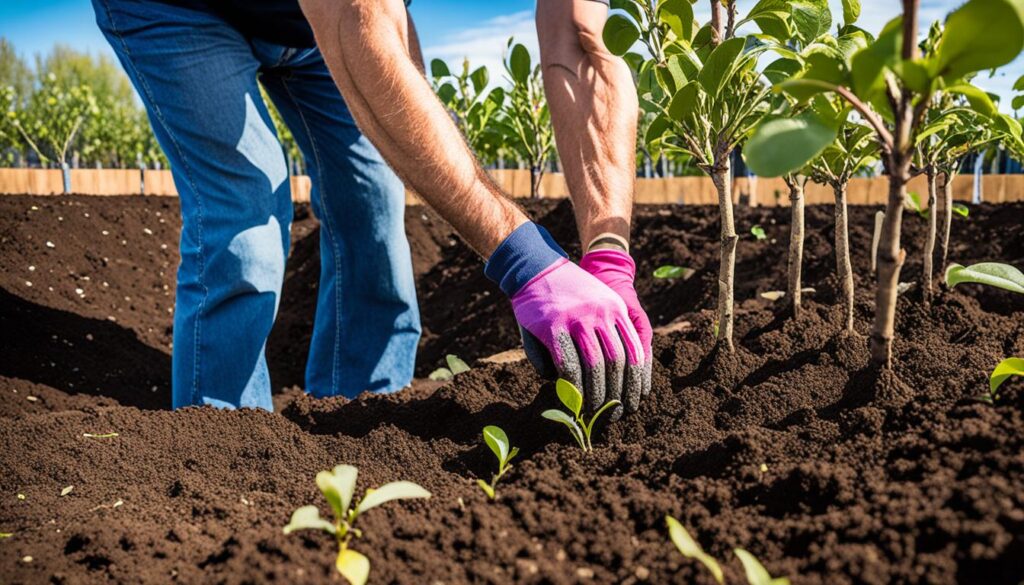
Caring for Your Pear Trees
Keeping your pear trees healthy is key for a good harvest. We’ll look at watering, fertilizing, and other important care tips.
Watering Needs for Pear Trees
New pear trees need about 1 inch of water a week to grow strong roots. After they’re set, give them deep water during dry times. This keeps the soil moist and helps them grow well. Add a 3-4 inch layer of mulch at the base to keep moisture in and stop weeds.
Fertilizing Pear Trees
Feed your pear trees with a balanced, slow-release fertilizer in early spring. Don’t give them fertilizer in August because it can harm them when it gets cold. Testing your soil can tell you exactly what nutrients your trees need. This ensures they grow strong and produce lots of fruit.
| Pear Tree Trait | Typical Measurement |
|---|---|
| Height | 15 to 30 feet (4.5 to 9 meters) |
| Maturity Age | 4-6 years after planting |
| Spacing Recommendation | 20 to 25 feet (6 to 7.5 meters) apart |
| Bloom Time | Early spring, April to May |
By watering and fertilizing your pear trees right, they’ll get the care they need. This helps them grow well and gives you a big harvest.
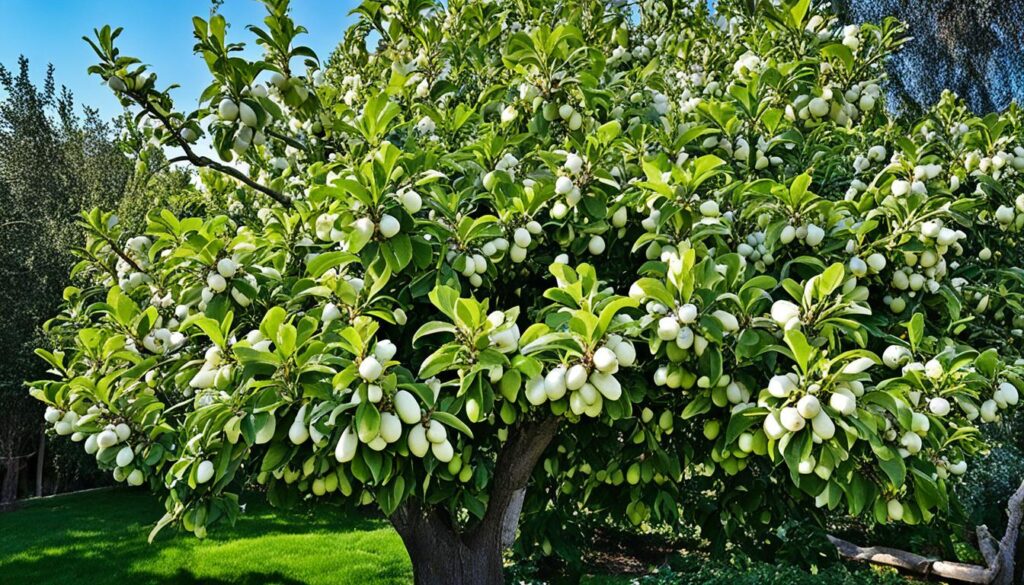
Pruning Techniques for Pear Trees
Proper pruning is key for pear trees’ health and growth. When you plant, prune to make a central leader and pick 3-5 scaffold branches that are well-spaced. Later, prune in the dormant season to thin out branches, remove suckers, and keep the tree’s shape and air flow. Summer pruning helps remove unwanted growth and control the tree’s size.
Training Young Pear Trees
Prune young pear trees lightly in their first one to three years to shape them. Cut off about 20% to 30% of the branches at once to tidy up the tree’s look. Removing watersprouts or suckers helps the tree focus on growing fruit.
- Take out branches that grow straight up or down, inward towards the trunk, and any that are damaged.
- Thin pear tree fruit buds to about 4 to 6 inches apart for sweeter and bigger fruit.
- Pruning older branches by 10% to 20% each year can make the tree look fresh and boost fruit production.
Pruning pear trees helps with airflow and stops diseases like canker, fire blight, and pear rust.
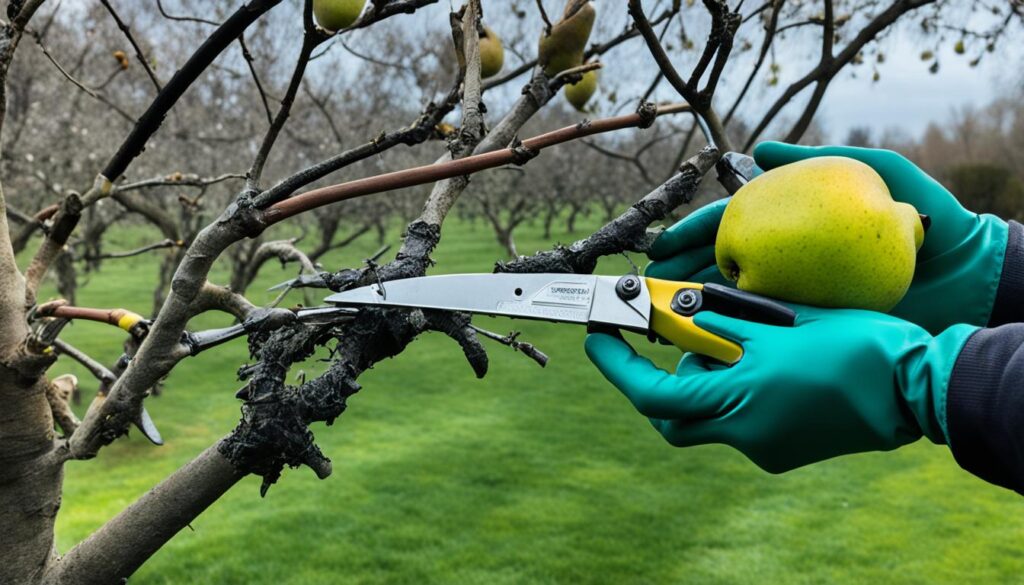
Pest and Disease Management
Keeping your pear trees healthy means watching out for pests and diseases. Pear trees can get many problems, like aphids and caterpillars, or serious diseases like fire blight and pear rust. It’s important to check on them often and treat any issues fast to stop these problems from spreading.
Fire blight is a big threat to pear trees. It’s caused by a harmful bacterium. This disease can quickly destroy blossoms, leaves, and branches. To fight it, cut out infected parts and use copper-based treatments.
Fungal diseases like pear rust and brown rot can also harm pear trees. You might need to cut out infected branches and use fungicides to stop these diseases from spreading.
Pear trees can also face pests like aphids, caterpillars, codling moth, and pear leaf blister mite. Using insect sprays or introducing helpful insects can help control these pests.
By being careful and using good pest and disease control, you can keep your pear trees healthy. Regular checks, targeted treatments, and taking care of your orchard are key to success.
Common Pear Tree Pests and Diseases
- Fire blight – a deadly bacterial disease that spreads fast
- Pear rust – a fungal disease that hits leaves, fruit, and branches
- Brown rot – a fungal disease that makes fruit decay
- Aphids – tiny insects that suck sap and slow tree growth
- Caterpillars – eat a lot and can strip trees bare
- Codling moth – its young eat into and damage fruit
- Pear leaf blister mite – causes blisters on leaves
By being alert and using good pest and disease control, you can keep your pear trees healthy. This way, you can enjoy a good harvest every year.
pear trees for Ornamental Beauty
Ornamental pear trees are more than just tasty fruit. They add beauty to gardens and cities with their spring flowers, fall colors, and elegant shapes. These trees are great for many garden designs.
These trees don’t produce much fruit, just about half an inch wide. They’re mainly grown for their looks, not for eating. You can find different kinds, like the tall ‘Aristocrat’ or the columnar ‘Capital’.
The ‘Bradford’ pear can grow up to 40 feet tall, with wide branches. But the ‘Fauer’ is much smaller, only about 20 feet tall. These trees grow well in zones 4 to 8. The Bradford Pear is tough and fights off pests and diseases well.
| Cultivar | Height | Habit | Bloom Season | USDA Zones |
|---|---|---|---|---|
| Aristocrat | Up to 50 ft (15 m) | Cone-shaped | Spring | 5-8 |
| Redspire | Up to 50 ft (15 m) | Cone-shaped | Spring | 5-8 |
| Capital | Up to 35 ft (11 m) | Columnar | Spring | 4-8 |
| Chanticleer | Up to 40 ft (12 m) | Pyramid-like | Spring | 4-8 |
| Bradford | Up to 40 ft (12 m) | Broad, horizontal | Spring | 5-9 |
| Fauer | Around 20 ft (6 m) | Compact | Spring | 4-8 |
Ornamental pear trees are great for any garden, big or small. They fit well in formal or casual settings. They’re a smart choice for landscape design and urban agriculture.
Harvesting and Storing Pears
Pear trees produce fruit in late summer to early fall. The best time to pick them is when they come off the branch easily at a horizontal angle. After picking, most pears need a few days to a week to ripen at room temperature before they’re ready to eat.
To keep your pears fresh, store them at 30°F with 90% humidity. This stops them from getting any riper and keeps them fresh for 2 to 4 months. Always check the stored fruit for mold or spoilage.
When you’re ready to eat your pears, let them ripen at room temperature. The time it takes to ripen depends on the type of pear. Bartletts ripen in 4-5 days, Bosc and Comice in 5-7 days, and Anjou in 7-10 days. To check if they’re ripe, gently press the pear’s neck. You can eat them fresh, can them, or use them in many tasty recipes.



